Clouds, Part 1
Mind you, I haven’t always been a cloudaholic. That’s just not possible when, like me, you were born and raised in inland Southern California where there are essentially 12 months of almost non-stop hazy sunshine and no such thing as seasons. The air pollutant known as smog only made matters worse when I was young, adding a dirty brown to the sky, completely hiding the local San Gabriel mountains from view, and causing chest pain unless you breathed very shallowly. And when there were clouds, instead of being the big, fluffy, billowy type, they were often gray and filled with pelting-down rain. (Disclaimer: while I wouldn’t also call myself a rainaholic, I actually enjoy the wet stuff up here in the Pacific Northwest and even start to miss it during any kind of dry spell.)
However, just because I’m a cloudaholic doesn’t mean I’m an expert on clouds. A meteorologist, I definitely am not. But having said that, it’s not like I’m a complete numbskull on the subject. Before doing any online research for this article, I made a list of cloud types, and I am pleased to say that while I could only come up with four – cumulus, cirrus, stratus, and nimbus – three of them are legitimate cloud types and the fourth (nimbus) wasn’t too far off the mark!
Lest I be accused of selfishness, let me share with you what I learned.
According to the World Meteorological Organization’s International Cloud Atlas, there are more than 100 types of clouds. In turn, all these variations are grouped into 10 basic types depending on their height in the sky and general shape. Here are the particulars:
- Low-level clouds (cumulus, stratus, stratocumulus) that lie below 6,500 feet. If you see any of those big, fluffy, billowy types that I mentioned above, they will most likely fall into the cumulus category.
- Middle clouds (altocumulus, nimbostratus, altostratus) that form between 6,500 and 20,000 feet. When the sky is covered by a dark gray layer of clouds that blots out the sun – ring a bell, by any chance? – they are probably of the nimbostratus variety.
- High-level clouds (cirrus, cirrocumulus, cirrostratus) that form above 20,000 feet. We’ve all seen those thin, white, wispy strands of clouds that streak across the sky, which I’ve always thought look pretty cool. Those would be cirrus clouds, which is Latin for “curl of hair.”
- Cumulonimbus, which broadly sweep across the low, middle, and upper atmospheres. There’s nothing petite about this cloud type, which typically grows from cumulus clouds and rises into towers with bulging upper portions that look like cauliflower. They aren’t always benign, however, as cumulonimbus clouds also include thunderstorm clouds.
If you’re hankering for more cloudology, please check out this article. But for now, let’s talk about local clouds – specifically, those often seen in the skies above Bainbridge Island and Puget Sound.
“DRIFTWOOD IV”
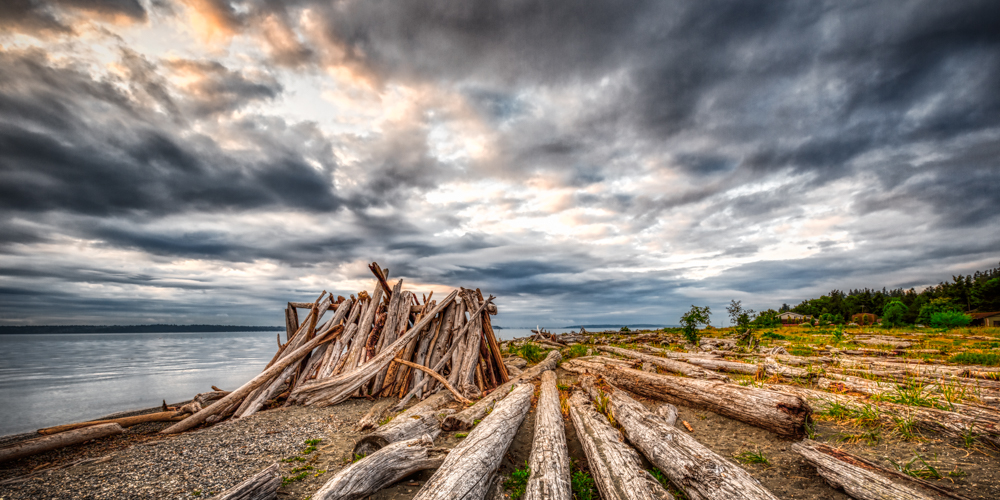
Bainbridge Island has a plethora of wonderful parks. While I wouldn’t want to be pinned down on my favorite, Fay Bainbridge Park would easily make my top five. With 1,420 feet of no-bank saltwater shoreline, the park features sandy beaches and sweeping views of Puget Sound and the Cascade Mountains. And did somebody mention “driftwood?” If you enjoy building forts or teepees – or whatever that structure in the above image is called – from marine debris, then this is your nirvana.
I’m honestly not sure what type of clouds is represented here. They look low-level to me, so I’ll say stratocumulus – but that’s admittedly only a guess. What I do know is that this particular shot was captured just after the crack of dawn one brisk morning in July. It was extremely peaceful to have the entire beach to myself.
A tidbit of island history. Many of you may know our island was named after Commodore William Bainbridge, an accomplished officer in the U.S. Navy who fought during the War of 1812 and enjoyed many notable victories at sea. But if you’re thinking his wife must’ve been named Fay, that would be wrong (her name was Susan). Instead, the park was named after Temple Fay, a famous neurosurgeon who introduced the use of hypothermia in medical and surgical illnesses and taught at the University of Washington. His estate sold the land to Washington State in 1944 for $5,000 with the express stipulation that the Fay name be retained. Originally named Fay Bainbridge State Park, it assumed its present name in 2011 after the land was officially transferred to our local park district.
“NEEDLE IN THE SKY”
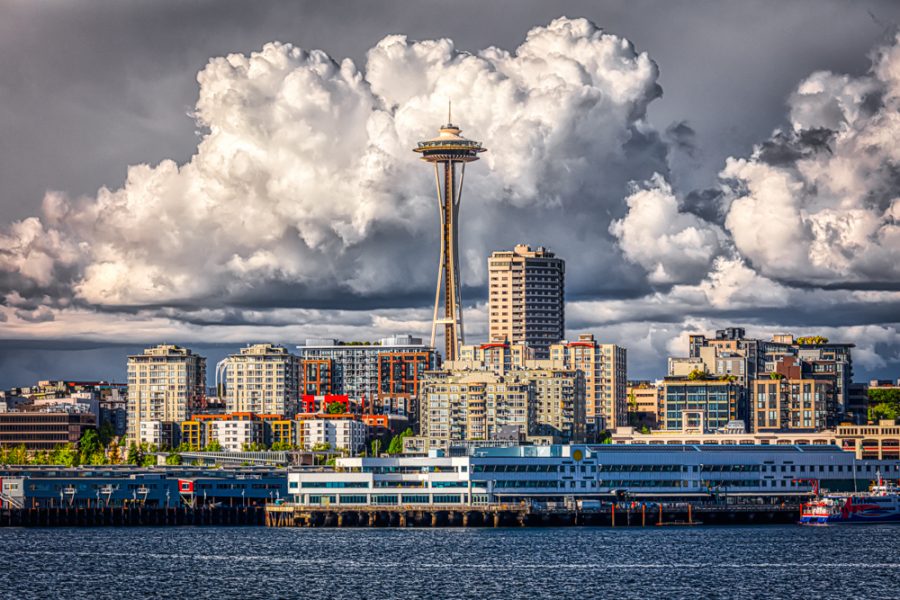
In so many respects the year 2020 was just a blur (though “bad nightmare” comes to mind too). My wife Carol and I returned on January 13 that year from a 12-day trip to Spain, where we had heard on the news about a small outbreak of infections in China. And then. . . .kaboom! Only two months later the U.S. government declared a nationwide emergency and numerous states, including Washington, began shutting down to avoid the spread of Covid-19. Fortunately, if one has to hunker down in a lockdown, Bainbridge Island is a great place to be. But it’s still hard to believe that by August 2020, ferry ridership was down 90 percent and one-boat ferry service had become the norm.
So why do I bring this up? Because I remember the circumstances leading up to the above image very well. It was May 19, 2021, and Carol and I were making an extremely rare ferry trip to Seattle to take my son out for dinner to celebrate his 35th birthday. I’m next to positive it was only our fifth or sixth ferry ride since the outbreak began – and it was so bizarre to be on what would usually be a prime-time ferry run but with so few fellow humans on board. Some things don’t change, however, so like I always do when it appears the weather is cooperating, I packed my camera hoping for the best. Sometimes it’s better to be lucky than good, and shortly before the ferry reached the terminal, the towering white billowy clouds – maybe cumulonimbus but I sure wouldn’t bet the farm on that – provided the perfect backdrop for the Space Needle. Although the ferry was still moving, I didn’t have to worry about freezing the action because the bright sun guaranteed a fast shutter speed.
“WING POINT PINKS”
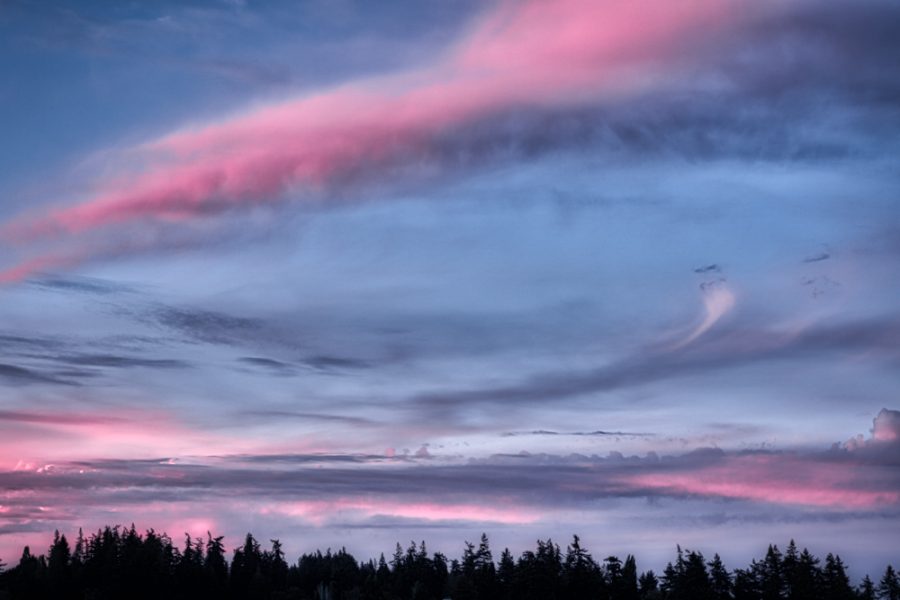
The last four images have something in common in that they were taken from almost but not quite the exact same spot. As I’ve said before, photographers always have some favorite “go-to” places where they feel comfortable and like their chances of capturing some nice shots. For me, one of those locations on the island is Pritchard Park on the south side of Eagle Harbor next to the old creosote plant, partly because it has a great sandy beach and exquisite view of the ferry terminal and the Olympics, but also because it’s just a seven-minute drive from our home.
When I shot “Wing Point Pinks,” I was actually at Pritchard Park one day in May to photograph the sun setting behind the Olympics. The clouds above the mountains were nothing special, so my expectations were low (which also makes it easier to avoid disappointment). One must not have tunnel vision, however, and after glancing to my right and seeing the developing pinks in the northerly sky, I immediately repositioned my tripod, waited for the right moment, and used the dark treeline for my foreground. These clouds look long and wispy-ish to me, so I’ll say they are of the cirrus genre – but once again, that’s only a guess.
“MORNING DRAMA”
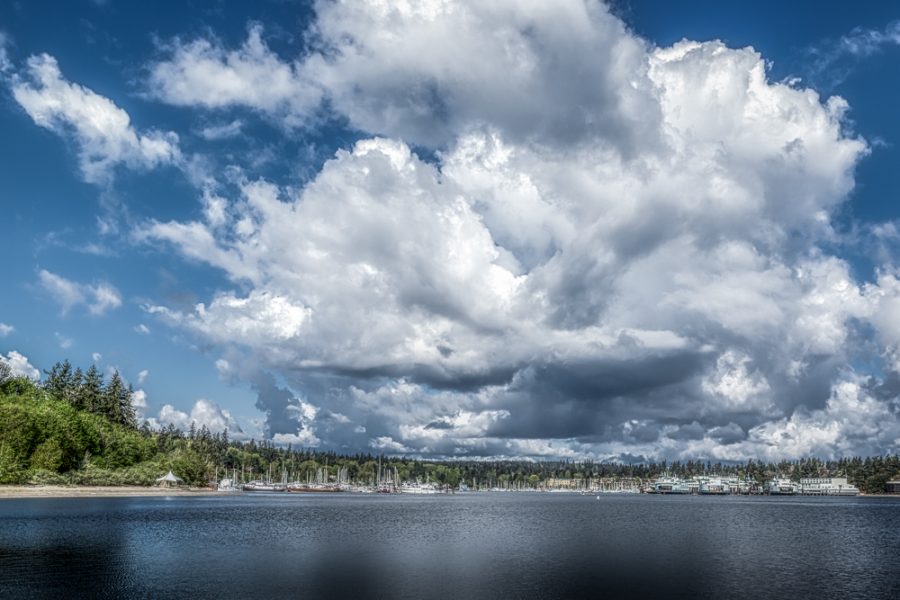
One April morning I was in a cloud-hunting mood. The problem is, it’s a bit of a crap shoot because unless you’re taking photos from your own property, you won’t know what you’ve got until you get to where you’re going. This is where my proximity to Pritchard Park really pays off, as I can be back in bed in just 20 minutes if the scouting report comes back negative. That wasn’t the case this time, however, as the clouds in “Morning Drama” – they’re probably of the cumulus variety, wouldn’t you agree? – were screaming to be photographed, and I was more than happy to oblige them.
“DAY’S END”
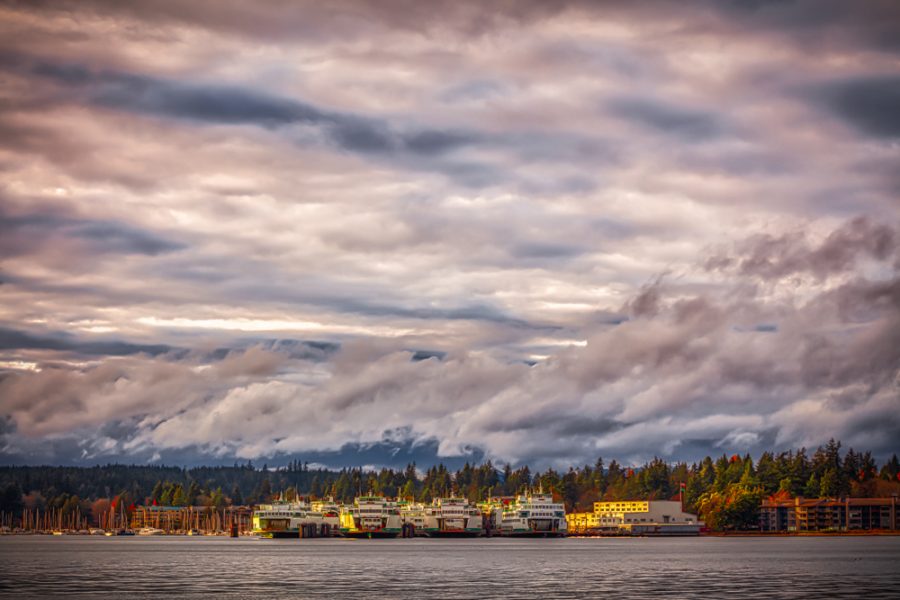
There is no way I’ll ever forget the circumstances of the above image, they are permanently etched in my brain. Besides, even if I do forget, Carol will be sure to remind me. The day was Thanksgiving 2020, right when everyone was deep in the throes of the pandemic. Masks and social distancing were mandatory, indoor gatherings were extremely limited, the prospect of vaccinations was still months away, and frankly, most of us simply didn’t want to risk either giving or getting an infection from someone outside our immediate household. Given this reality, Carol and I decided to quietly celebrate Thanksgiving together with a late afternoon picnic at Pritchard Park, complete with a bottle of Mumm Champagne. Except for a few dog walkers, we had the entire beach to ourselves. But besides popping the champagne, I also popped the question to Carol. Yes, that question. As planned, Carol was in a weakened state from the champagne and blurted out yes – so it seemed only appropriate to memorialize the occasion with a photograph. As for which cloud types are depicted in this image, however, your guess is as good as mine! (I think there might be more than just one.) In any event, Carol and I exchanged vows one month later in a small ceremony at a certain park just seven minutes from our home.
“WING POINT WATERFRONT”
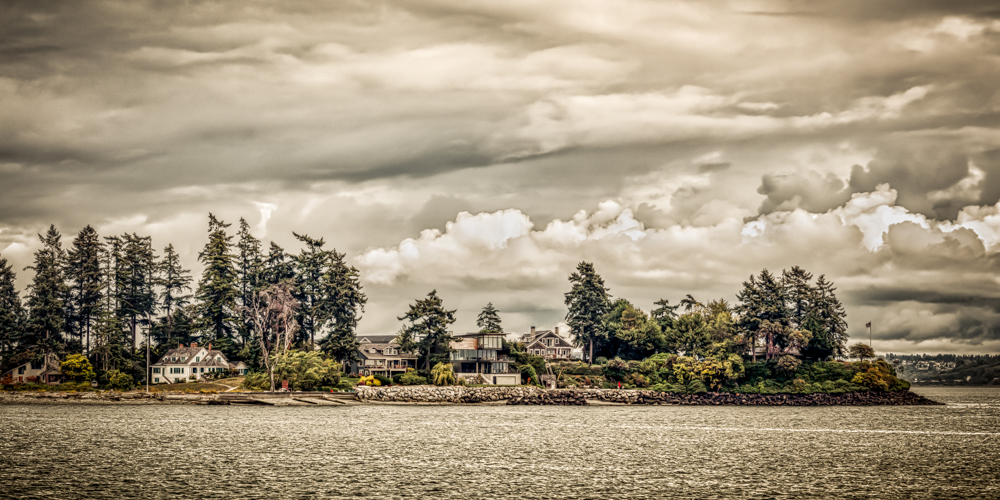
This final image was taken just east of the creosote plant where there is an incredible vista view of Puget Sound, including Seattle and Mount Rainier. Whaddaythink – more nimbostratus clouds? I will confess that I’ve always had a soft spot for the Wing Point area, as my family lived in that neighborhood when we first moved to Bainbridge Island in 1988. One of our favorite walks (though I’m probably not speaking for my two children) was a loop that included the fun-to-explore beach in the inner harbor. I love the two-story white house in the left center of the image, in my mind it would have been the perfect set for the Cleaver family if “Leave It To Beaver” had been filmed in the Pacific Northwest. (I realize I’m dating myself – but that’s okay!)
Bergh Images
Facebook – Instagram – Website
NEXT MONTH: We are not yet done with clouds! Thanks to its irregular shape, Bainbridge Island has lots of picturesque harbors, bays, and inlets – and when you combine clouds with calm, tranquil waters at the right time of day, wonderful reflections are often the result. I will present my case in my next article entitled “Clouds, Part 2.”
PREVIOUS ARTICLES:
Island Images Volume #2
Island Images with Andrew (“Andy”) Bergh

ABOUT ANDREW BERGH: Local artist Andrew (“Andy”) Bergh is a long-time Bainbridge Islander (33+ years), whose successful transition from law to photography began in 2010. After displaying his unique and evocative images at different venues, including the Bainbridge Island Studio Tours, the Saturday Farmers Market, and various local businesses, Andy took the big plunge in September 2018 when he opened his own gallery – Bergh Images – in downtown Winslow. His prints are offered in different mediums, including metal, canvas, and fine art acrylic prints; matted prints; and custom-framed black and white prints. Andy has an online presence at https://berghimages.com/, which also features his entertaining travel blog. The gallery is open every day but Monday, with Andy and his wife Carol regularly participating in the monthly First Friday Art Walks sponsored by the Bainbridge Island Downtown Association.
Facebook – Instagram – Website